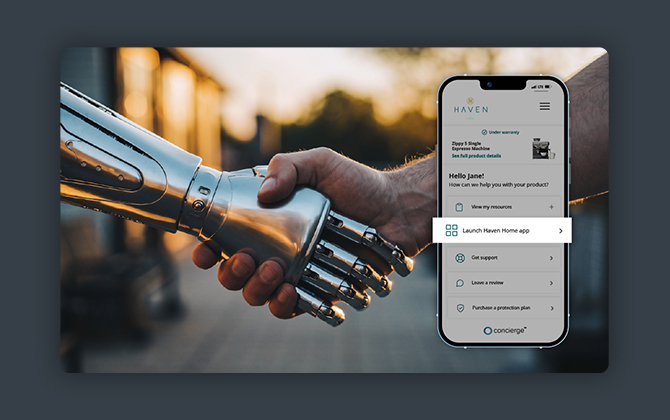As AI gets smarter, where does that leave your app?
Futureproof your brand app so it keeps earning attention When was the last time you actually useda brand app? Maybe it came with your new coffee...
OUR SOLUTIONS
OUR TECHNOLOGY

The foundation for successful Ownership Experiences (OX) is customer data; specifically, high-quality “brand-owned,” first-party data. Leveraging this data to produce meaningful customer interactions requires technology that combines the best of both human engineering and artificial intelligence. For instance, this balance of AI with human ingenuity is paramount to how we have developed our OXM Platform, which pairs customer and product data with AI-based decision logic to help product owners easily access relevant information on demand.
AI is a hot topic. While some speculate about its potential to replace jobs and dominate the world, we believe in applying technology to enhance and optimize the product Ownership Experience.
Many brands are wondering how and if they should incorporate AI into their OX, asking questions like what's the right approach, where’s the payoff, is there risk, is it all hype? Other brands have already taken the leap and are learning how AI can enhance both their internal and customer-facing processes. However, not all AI approaches are created equal. AI can have both a positive and a negative impact on the future of your brand. Here's our insight into how you can best use AI in the OX.

Artificial intelligence refers to the ability of machines, specifically computers, to perform tasks that have previously required hands-on work. This can include capabilities such as real-time natural language processing, pattern recognition based on analysis of historical data, and applying user-specific context to data to help extract valuable insights. All of which helps make better decisions on behalf of consumers, brands, and the OXM Platform.
Personalization may not come to mind when you think of AI, especially if you have tried to interact with an AI chatbot that proves to be nothing more than an automated system with limited response capability. In many cases, this type of AI is not equipped to answer your question or provide the information you need, in part because it doesn’t have access to personalized information. Even if the brand collects this type of data, it still needs to be intelligently and reliably integrated into the chatbot to enable personalized interactions.
AI that bases responses on actual customer data, as well as customer preferences and behavior, can be used to tailor responses and content that is actually relevant and helpful to the customer. This type of AI-driven content personalization offers a myriad of use cases that improve the Ownership Experience. For example:
Many product brands collect the type of data needed to optimize these types of customer interactions, but they are either unsure of how to integrate it into existing systems or simply haven’t prioritized doing so. The benefits, however, far outweigh the learning curve and investment, especially if they take advantage of a proven platform that integrates into their existing tech stack.
Like AI-driven content personalization, machine learning (ML) begins with specific data collection to build a profile for each individual. Using this historical data and one or more algorithms, the ML model is then trained to identify patterns and similarities between individual profiles. Based on these results, a customer-facing system can be designed to make personalized recommendations. Feedback from these recommendations is fed back into the model, which adapts and improves its performance over time.
Machine learning is used by companies to analyze customer data and behaviors, enabling them to create tailored experiences, recommendations, and communication that better match each individual's preferences and needs.
Use case examples include:
Registria uses machine learning to analyze and extract meaningful information from images. Photoregister uses internally developed computer vision models and deep learning algorithms to analyze images and generate a comprehensive analysis of the extracted content, including confidence factors which help maintain a high-level of accurate results and responses back to consumers.
Natural Language Processing (NLP) is a field of artificial intelligence that focuses on teaching computers to understand, interpret, and generate human language. It involves programming computers to process and analyze text or speech in a way that allows them to comprehend meaning, extract information, and respond in a human-like manner. NLP algorithms use patterns, statistical models, and linguistic rules to transform raw language data into structured information that machines can work with effectively.
One of the ways brands are leveraging NLP is for sentiment analysis to gauge customer satisfaction and sentiment across various feedback channels, including social media. Another use of NLP is embedded speech recognition, which is becoming more common across different product types.
NLP encompasses a wide range of tasks, such as language understanding, language generation, machine translation, and more. It will be interesting to see how more brands leverage NLP in the future to enhance the Ownership Experience.
In addition to the examples above of how product brands can use AI to improve the Ownership Experience, other AI methods can be used to innovate products and streamline production.
AI-assisted product design can enhance various aspects of the product development process and help companies create better, more innovative offerings. Examples include:
Predictive analytics is a method that leverages data analysis and statistical algorithms to forecast future events or outcomes based on historical and current data. Paired with AI in the context of product manufacturing, predictive analytics can play a significant role in improving operational processes, particularly in areas such as inventory management.
Use cases include:
Incorporating AI into operational processes can improve a manufacturer's ability to make informed decisions, optimize resource allocation, reduce costs, enhance customer satisfaction, and ultimately improve their overall efficiency and competitiveness in the market.
As brands continue to grow their investment in AI technology, it’s important to keep in mind that AI in and of itself should not be the goal. AI is a tool that brands can leverage to deliver a positive, memorable and valuable Ownership Experience. This powerful tool, in conjunction with human ingenuity and ethical application, can be used throughout the Ownership Lifecycle, in a myriad of ways.
At Registria, we continue to explore new applications of AI to help brands connect with their product owners and deliver exceptional Ownership Experiences. We’ll be sharing some of our AI initiatives in a follow-up blog post, so stay tuned!

Futureproof your brand app so it keeps earning attention When was the last time you actually useda brand app? Maybe it came with your new coffee...

Registria CEO Collin Cohen shares his valuable insights on mastering customer relationships in the digital age in an article featured on Fast Company...

Registria CEO Collin Cohen shares his valuable insights on how Prime Day sales success hinges on post-purchase experience in an article featured on ...